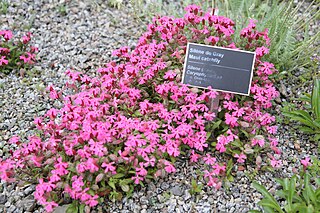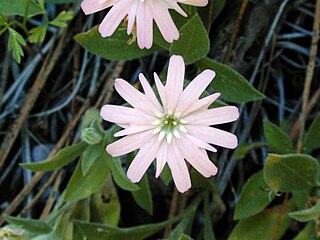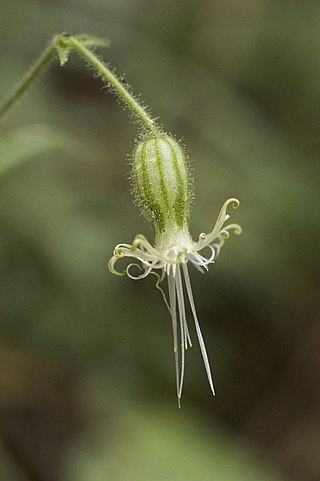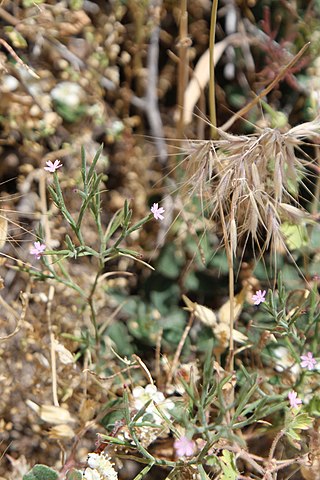
Eremogone aculeata is a species of flowering plant in the family Caryophyllaceae known by the common name prickly sandwort. It is native to the western United States, where it grows in the southern sagebrush steppe, mountainous areas, and volcanic soils, as well as on rocky slopes.
Eremogone macradenia is a species of flowering plant in the family Caryophyllaceae known by the common names Mojave sandwort and desert sandwort.

Eremogone ursina is a species of flowering plant in the family Caryophyllaceae known by the common name Bear Valley sandwort.
Minuartia decumbens is a rare species of flowering plant in the family Caryophyllaceae known by the common names The Lassics sandwort and Lassicus stitchwort.

Minuartia stolonifera is a rare species of flowering plant in the pink family known by the common names Scott Mountain sandwort and stolon sandwort.

Minuartia stricta is a species of flowering plant in the family Caryophyllaceae known by the common names bog stitchwort, Teesdale sandwort and rock sandwort. It has a circumboreal distribution, occurring throughout much of the northernmost Northern Hemisphere from the lower Arctic into the alpine climates of mountainous areas in temperate Eurasia and North America. It grows in several types of habitat, including meadows, marshes, heath, beaches and bars, and arctic and alpine tundra.

Pseudostellaria sierrae is a species of flowering plant in the family Caryophyllaceae known by the common name Sierra starwort.
Silene serpentinicola is a rare species of flowering plant in the family Caryophyllaceae known by the common name serpentine Indian pink and serpentine catchfly.

Silene grayi is a North American species of flowering plant in the family Caryophyllaceae, known by the common name Gray's catchfly.

Silene hookeri is a species of flowering plant in the family Caryophyllaceae known by the common names Hooker's silene, Hooker's catchfly, Hooker's Indian pink, and Hooker's glandular campion.
Silene salmonacea is a rare, newly described species of flowering plant in the family Caryophyllaceae known by the common names Klamath Mountain catchfly and salmon-flowered catchfly. It is known only from Trinity County, California, where it grows in the forests of the southern Klamath Mountains. It is a member of the serpentine soils flora. It is a small perennial herb growing just a few centimeters tall. The spoon-shaped leaves are up to 3.5 centimeters long. The herbage is gray-green and lightly woolly in texture. Each flower has a tubular calyx of fused sepals lined with ten veins. There are five salmon pink petals, each with four lobes at the tip.

Silene lemmonii is a species of flowering plant in the family Caryophyllaceae known by the common name Lemmon's catchfly.
Silene marmorensis is a rare species of flowering plant in the family Caryophyllaceae known by the common names Marble Mountain catchfly, Marble Mountain campion, and Somes Bar campion. It is endemic to the southern Klamath Mountains of northern California, where it grows in mountain woodlands and forests. It is a perennial herb producing several stems and shoots from a woody, branching caudex and thick taproot. The hairy, glandular stems grow erect to a maximum height near 40 centimeters. The lance-shaped leaves are a few centimeters long and are borne in pairs, the lowermost drying early. The inflorescence is a terminal cyme of flowers at the top of the stem, and some flowers may occur in the leaf axils. Each flower has a hairy, veined calyx of fused sepals. The flowers bloom at night, the five pinkish or green-tinged petals opening at the tip of the calyx.

Silene occidentalis is a species of flowering plant in the family Caryophyllaceae known by the common names western catchfly and western campion.

Spergularia canadensis is a species of flowering plant in the family Caryophyllaceae, known by the common name Canadian sandspurry. It is native to North America, where it is known from mainly coastal habitat. It is found along the coastline of Canada and northern parts of the United States, from Alaska to northern California on the West Coast, and as far south as New York on the East Coast.

Spergularia macrotheca is a species of flowering plant in the family Caryophyllaceae known by the common name sticky sandspurry. It is native to western North America from British Columbia to Baja California, where it grows in many types of moist coastal and inland habitat, often in alkaline and saline substrates. It may be found in marshes, alkali flats, beaches, meadows, seeps, and vernal pools. It is a perennial herb producing a narrow stem up to 40 centimeters long with a woody, thickened base and taproot. They may grow erect or prostrate across the ground. It is covered in sticky glandular hairs, especially in the inflorescence. The stems are lined with fleshy linear leaves, sometimes tipped with spines. The leaves are accompanied by triangular stipules up to a centimeter long each. Flowers occur in clusters at the end of the stem as well as in leaf axils. The small flowers have five pointed sepals and five oval white to lavender-pink petals. The fruit is a capsule containing tiny reddish brown, winged seeds.

Stellaria crispa is a species of flowering plant in the family Caryophyllaceae known by the common names curled starwort and crisp starwort. It is native to western North America from Alaska south to California and Wyoming, where it grows in moist, shady habitat such as deep forests and streambanks. It is a rhizomatous perennial herb producing a mat of prostrate or trailing stems up to about 40 centimeters long. It is lined with opposite pairs of pointed oval leaves each 1 to 2 centimeters long. Single flowers occur in the leaf axils, each borne on a short pedicel. The flower has five pointed green sepals each a few millimeters long. Some flowers have one or more petals, but most lack these.

Stellaria obtusa is a species of flowering plant in the family Caryophyllaceae known by the common names Rocky Mountain chickweed, blunt-sepaled starwort, and obtuse starwort. It is native to western North America, from British Columbia and Alberta to California to Colorado, where it grows in moist areas in forests and on mountain slopes.

Velezia rigida is a species of flowering plant in the family Caryophyllaceae. It is native to southern Europe. It is also present in northern California where it is an introduced species. It is an annual herb growing from a taproot and producing a hairy, glandular, branching green or purplish stem up to 40 centimeters tall. The linear leaves are up to 2 centimeters long. Solitary flowers occur in the leaf axils. Each flower has a very long, cylindrical, ribbed calyx of fused sepals forming the tubular throat of the flower, measuring at least a centimeter in length. At the top of the tube is the flower corolla which has five pink or purplish petals.
Minuartia cismontana is a species of flowering plant in the family Caryophyllaceae known by the common name cismontane minuartia.














